This article selects the world's second largest same-sex dating website StackOverflow Most praised in the world 10 A question , The total number of likes exceeded 5 ten thousand , Considering a lot of white whores , There are at least 10 Ten thousand people are interested in these problems !

So many people like it , Explain two questions :
1. These questions are very common , When programming, we often encounter
2. These questions are not simple , Otherwise you don't have to go to the forum
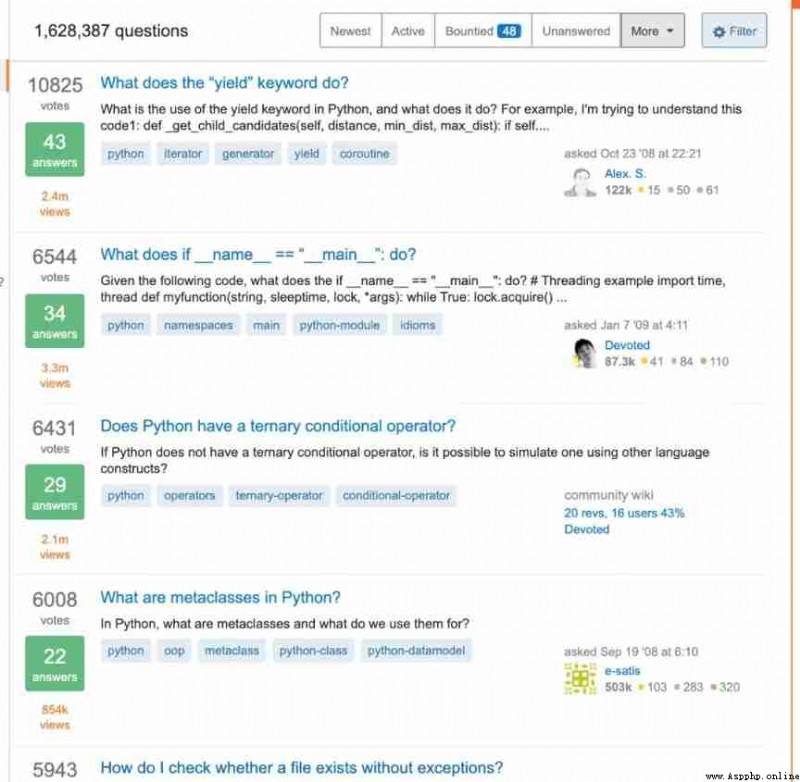
this 10 A question , Some are complicated , Some are simple . How many do you know ? Leave a comment in the comments section .
I was going to explain 10 A question , But because of the space , This article covers only one of the most frequently asked questions , Subsequent articles may cover a number of issues .
Now let's focus on the first question :
The problem is all Python Top of the list of problems :
Yield What is the key word ?
Consider the following code :
def _get_child_candidates(self, distance, min_dist, max_dist):
if self._leftchild and distance - max_dist < self._median:
yield self._leftchild
if self._rightchild and distance + max_dist >= self._median:
yield self._rightchild
This is the calling code :
result, candidates = [], [self]
while candidates:
node = candidates.pop()
distance = node._get_dist(obj)
if distance <= max_dist and distance >= min_dist:
result.extend(node._values)
candidates.extend(node._get_child_candidates(distance, min_dist, max_dist))
return result
When _get_child_candidates When called , What happened? ? Returned a list Do you ? It's still an element ? Will it be tuned over and over again ? When do subsequent calls stop ?
Looking a little confused ? You can continue to look at the solution , And then come back to the question .
To understand yield, To understand first generators, To understand generators To understand first iterable( Iterable ).
Iterables
When you create 1 individual list, You can read it one by one , It's called iteration :
>>> mylist = [1, 2, 3]
>>> for i in mylist:
... print(i)
1
2
3
above mylist It's a iterable( Can be iterated ). When you use a list derivation , You create a list , That's one iterable:
>>> mylist = [x*x for x in range(3)]
>>> for i in mylist:
... print(i)
0
1
4
So you can use for…in… What syntax traverses is iterable:list, str, file wait
these iterable It is useful to , You can cycle through them . But all of their values are in memory . If your list There is 10 100 million strings , To create this list It's going to be slow , And it takes up a lot of memory , So we need Genertor.
Generators
Generator yes iterable, Can be recycled . But it's not the same as above , It can only be cycled once . It doesn't keep all the values in memory , They dynamically generate the values of the elements in the loop .
>>> mygenerator = (x*x for x in range(3))
>>> for i in mygenerator:
... print(i)
0
1
4
This generator is almost the same as the list derivation , The only difference is the use of parentheses (), Not brackets []. but , You can't use it twice for i in mygenerator, Because the generator can only be cycled once : They calculate 0x0, Return results , I don't keep it myself , Next time you call it , He calculated 1x1, And so on .
Yield
Yields It's a key word , It can be understood as and return equally , The difference is that it returns a generator.
>>> def createGenerator():
... mylist = range(3)
... for i in mylist:
... yield i*i
...
>>> mygenerator = createGenerator() # create a generator
>>> print(mygenerator) # mygenerator is an object!
<generator object createGenerator at 0xb7555c34>
>>> for i in mygenerator:
... print(i)
0
1
4
The above example creates range, Has taken up memory , But the square doesn't take up . This example is not very good , This is the original author's example , There should be a better example in my video .
First , because yield The existence of , When you call the function above , The code is not executed , Instead of returning a Generator.
And then there's the key :
Now let's look at the first question :
This is a tree traversal algorithm , Find the eligible nodes in the tree . Detailed Chinese comments are added to the code .
Generator:
# This function returns a generator (Generator), This is a binary tree node Methods in objects
def _get_child_candidates(self, distance, min_dist, max_dist):
# If there's a left child , And the distance meets the requirements , Back to the left child , And then pause here
if self._leftchild and distance - max_dist < self._median:
yield self._leftchild
# If there's a right child , And the distance meets the requirements , Back to right child , And then pause here
if self._rightchild and distance + max_dist >= self._median:
yield self._rightchild
# If it's done here , It means that there are no qualified left and right children , The generator is empty , It's the end of the iteration .
Caller:
# Create an empty list , And the current object node
result, candidates = list(), [self]
# loop , In the beginning, it was just myself
while candidates:
# Pop up the last node
node = candidates.pop()
# get obj The distance between the object and the target node
distance = node._get_dist(obj)
# If distance ok, Write to the result list
if distance <= max_dist and distance >= min_dist:
result.extend(node._values)
# Add your own child node to the candidates in , So the cycle will continue , Until all the nodes in the tree are traversed
candidates.extend(node._get_child_candidates(distance, min_dist, max_dist))
return result
Learn from good examples Python Whether it's employment or sideline, it's good to make money , But learn to Python Still have a learning plan . Finally, let's share a complete set of Python Learning materials , For those who want to learn Python Let's have a little help !
Python All directions are Python Sort out the common technical points , Form a summary of knowledge points in various fields , The use of it is , You can find the corresponding learning resources according to the above knowledge points , Make sure you learn more comprehensively .
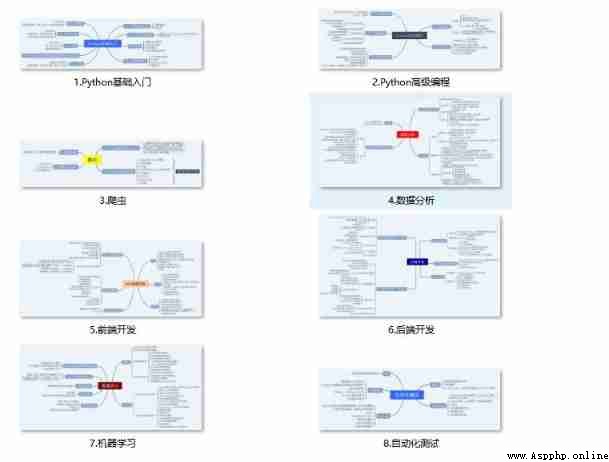
If a worker wants to do a good job, he must sharpen his tools first . Study Python Common development software is here , It saves you a lot of time .

When we were watching videos to learn , You can't just move your eyes and brain without hands , A more scientific way to learn is to use them after understanding , At this time, the hand training program is very suitable .
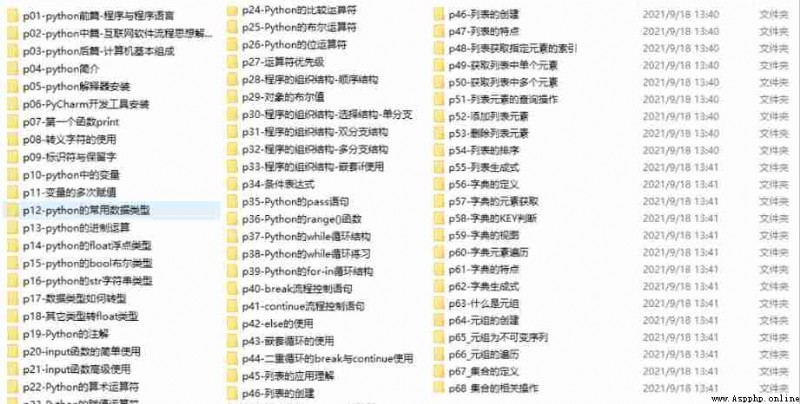
Optical theory is useless , Learn to knock together , Do it , Can you apply what you have learned to practice , At this time, we can make some practical cases to learn .

We learn Python Must be to find a well paid job , The following interview questions are from Ali 、 tencent 、 The latest interview materials of big Internet companies such as byte , And the leader Ali gave an authoritative answer , After brushing this set of interview materials, I believe everyone can find a satisfactory job .

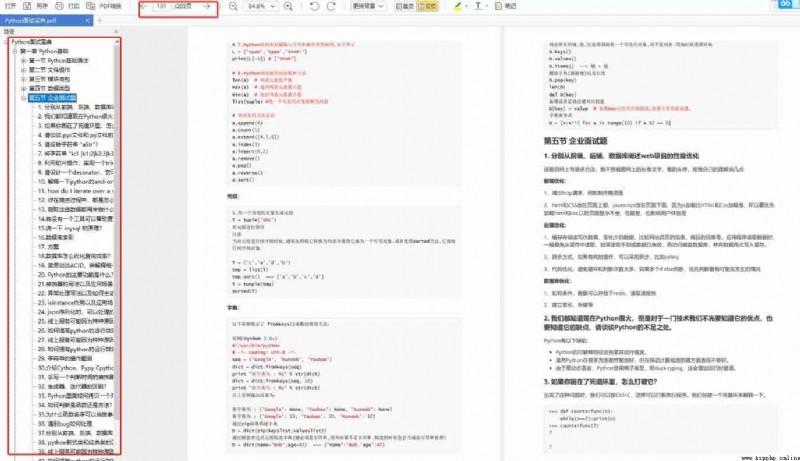
Guarantee 100% free 】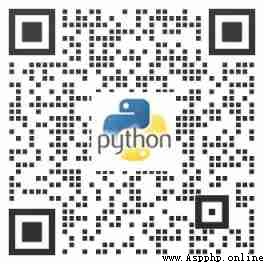
 Who says straight men cant confess? Valentines day teaches you to send love in Python code
Who says straight men cant confess? Valentines day teaches you to send love in Python code
Its today 214 Valentines Day ,
 Python Tkinter - Chapter 9 method of multi selection button control (checkbutton)
Python Tkinter - Chapter 9 method of multi selection button control (checkbutton)
9.2 How to select multiple but